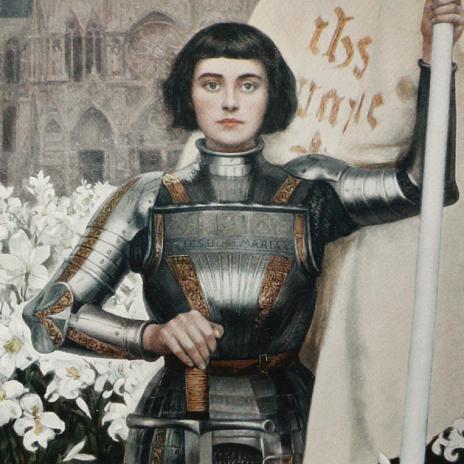

Strong women in Opera: Joan of Arc
On 19 April 1909, over 30,000 people gathered in St. Peter's Basilica in Rome to witness the beatification of Joan of Arc. The New York Times reported that, at unveiling her statue, ‘many of the pilgrims, overcome, burst into frantic cheers, which were immediately suppressed’ so that the ceremony could continue. Who is behind the historical Joan of Arc, the famous Maid of Orléans?
The beginning of the 15th century: France is in the midst of the Hundred Years’ War, large parts of the country are occupied by English troops and the powerful Duke of Burgundy, allied with King Henry V, rules in the west. In March 1429, when the enemies of the French king Charles VII are about to conquer the strategically favourable location of Orléans, a peasant girl appears before the king and stirs things up. She calls herself Jeanne ‘la Pucelle’ (the Virgin) and claims to be guided by the voices of Saints Catherine and Margaret and the Archangel Michael, who have given her a divine mission to liberate France from the English.
Despite no combat experience, Jeanne is deployed at the head of the French troops. Indeed, after the successful liberation of Orléans in May 1429, they celebrate one victory after another. It was clear to everyone that Jeanne must be the reason for this. However, during a planned re-conquest of Paris, Jeanne is captured by the Burgundians and handed over to the English. In order to get Jeanne out of the way as quickly as possible, an inquisition trial is organised; a woman going into battle in men’s clothing can only be sinful! Only 19 years old, Jeanne is found guilty and burned at the stake as a heretic in Rouen on 30 May 1431.

There are numerous legends surrounding Joan of Arc, who has been honoured as a patron saint of France and has received countless tributes ever since. As a religious fanatic, brave warrior or emancipated woman who was able to assert herself in a male-dominated world, she is a colourful figure who has repeatedly inspired composers to create music theatre works, especially since the 19th century, including Tchaikovsky, Rossini, Verdi and Honegger.
With grand gestures and powerful choral numbers, Verdi’s Giovanna d’Arco interprets historical events in a monumental way. Joan/Giovanna is mostly portrayed in her role as a spiritual leader. Giovanna’s very first appearance is accompanied by an otherworldly choir of evil spirits and angels preparing her for her divine mission, accompanied by the elegant sound of harp music. In the course of the opera, Giovanna is never seen as a quick-tempered warrior. Rather, in the midst of the noise of events around her, she appears like the peaceful eye of the storm – a gentle voice of reason in turbulent times, who is characterised by cantabile music: the richly ornamented andante of her prayer in the prologue; the graceful pastorale ‘O fatidica foresta’; the extended melodious line over a largely sparse instrumental accompaniment in the finale of Act II, in which the vulnerability of the protagonist is revealed.
There are certain practical reasons for this compositional treatment. Verdi wrote his Giovanna for Erminia Frezzolini, who sang the title role at the premiere in 1845. According to contemporary sources, the soprano had a delicate voice with a ‘heavenly sweetness’ – in other words, a voice that did not go hand in hand with Joan of Arc’s combative nature. It is possible that Verdi’s Giovanna remains a rather passive figure alongside the other male roles for precisely these musical reasons – which in turn promises exciting possibilities for modern stagings!
The Polish National Opera delivered a contemporary take on Joan of Arc with its site-specific and cross-genre production D'ARC, commissioned for the Warsaw Rising Museum, which was also shown on OperaVision. Almost two centuries after Verdi, this production focuses on the courageous fighter Joan of Arc, who becomes an emancipatory role model alongside the heroines of recent history.
Hannes Föst
Translated from the German original




